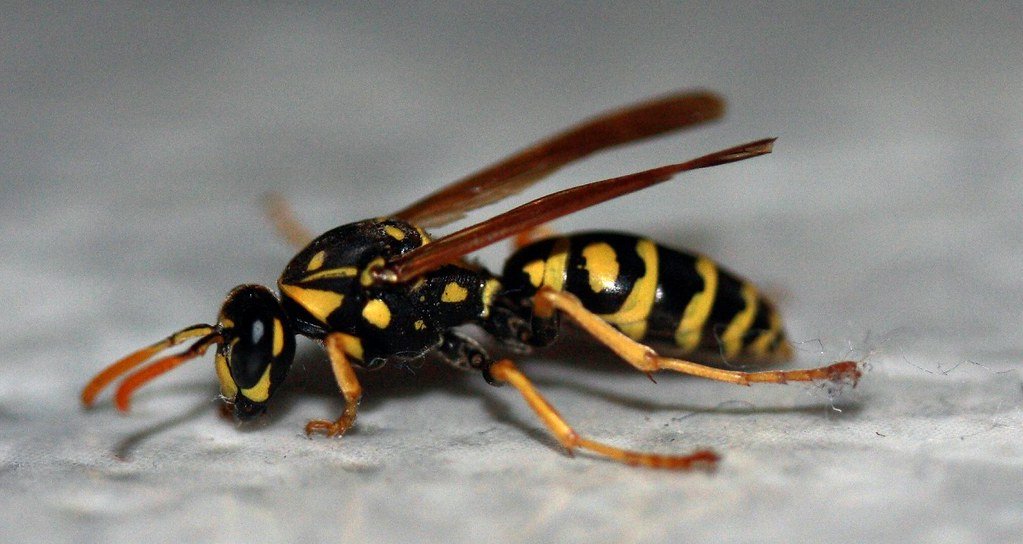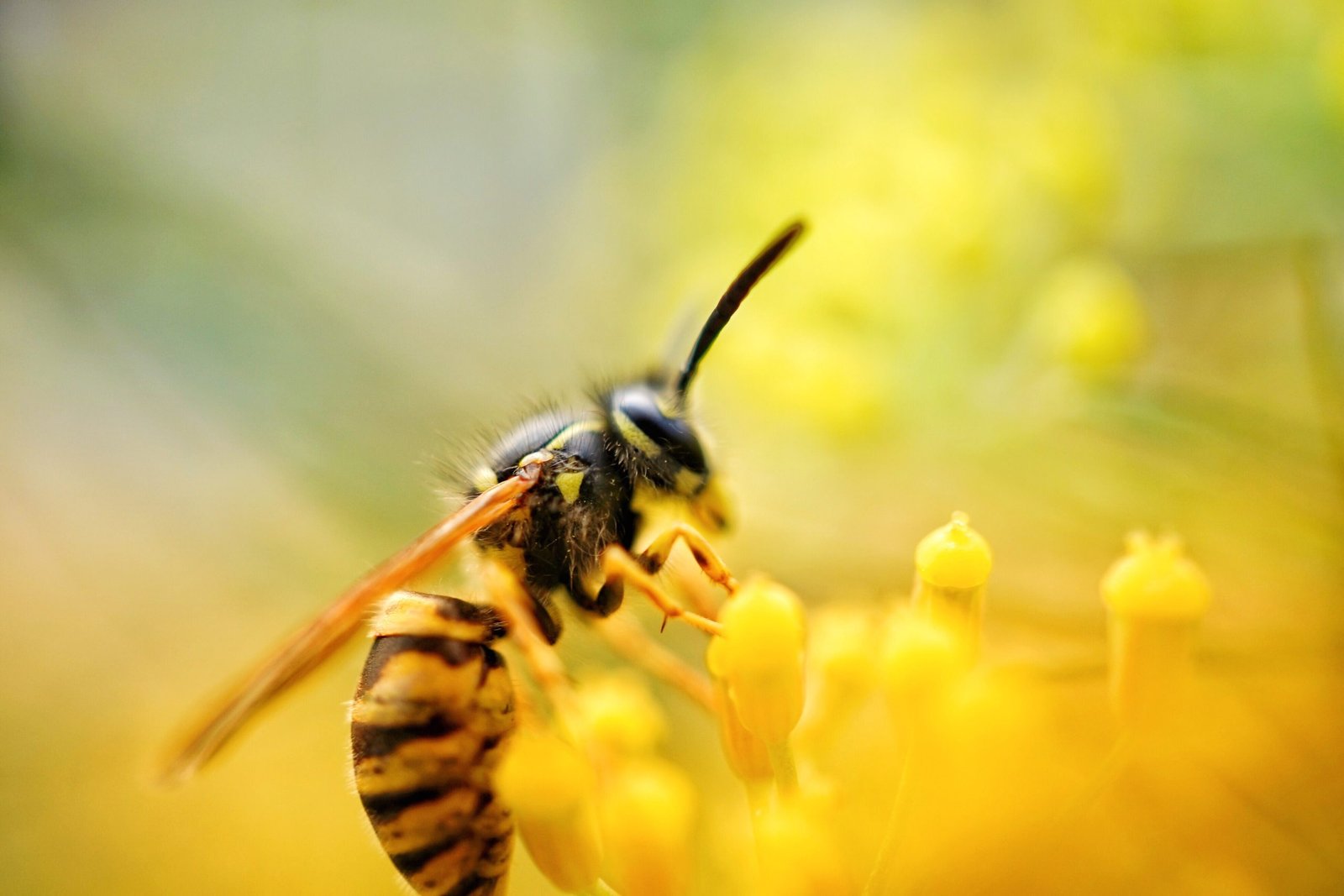Yellowjacket: Vespula and Dolichovespula

Description Of The Yellowjacket
The word ‘yellowjacket’ refers to many different wasp species in the Vespula and Dolichovespula genera (family Vespidae). The yellowjacket is the most commonly found species and is sometimes referred to as the meat bee, and is included in this group of ground-nesting species. The yellow jacket is common in the majority of U.S. states and can be found around homes, parks, and wilderness.
These wasps tend to be medium-sized and black with jagged bands of bright yellow or white. The area that connects the abdomen and the thorax is concise and is followed by a narrow waist.
White grublike larvae that become white pupae are immature yellowjackets. Just before they emerge as adult wasps, the pupae develop adult coloration. Unless the nest is torn open or a sudden loss of adult caretakers leads to an exodus of starving larvae, immaturity is usually not seen. 1Go To Source ipm.ucanr.edu -“Yellowjackets and Other Social Wasps”
Learn More: Flying Stinging Insects Identification
Yellowjacket Behavior
Generally, the Eastern Yellowjacket is a peaceful creature, but it will not hesitate to attack when it feels threatened. Vespula maculifrons’ stinger is used for defense only and does not play a role in capturing prey. Instead, yellow jackets use their powerful jaws (mandibles) to capture and kill prey and sometimes bite and sting while defending themselves with these mandibles.
One interesting habit of the Eastern Yellowjacket is that once the queen begins laying the male and female eggs, all the undeveloped larvae that have not yet hatched are eaten by the workers. Scientists do not understand why this is but believe that all the colony’s attention and energy focus on the next season’s queens. 2Go To Source animaldiversity.org -“Vespula maculifrons”
Reproduction Cycle Of Yellowjackets

The only colony members capable of surviving the winter are Queens. In April or May, each queen selects an appropriate location, constructs a small nest, and begins to raise the sterile offspring. These workers take over the tasks of enlarging and maintaining the nest, foraging for food, and caring for the offspring, while the queen only works to produce offspring.
The queen yellow jacket is the only wasp in the colony that lays eggs. The queen fertilizes each egg when it is laid using stored sperm from spermatheca. The queen will not fertilize the egg from time to time. The non-fertilized eggs only have half the amount of genes the workers and queen have, resulting in the eggs developing into drones (males).
The mature colony includes a queen, 2,000-4,000 winged infertile female workers, brood (eggs, larvae, and pupae), and, in late summer, males and reproductive females. 3Go To Source naturemappingfoundation.org -“Yellow Jacket”
Yellowjacket Habitat
Yellowjackets are constructors of nests. In late fall, old queens and colonies die off, while newly fertilized queens prepare for overwintering. In leaf litter, underground, or old logs, they look for a warm place to live. A queen yellow jacket, such as an eastern yellow jacket or a southern yellowjacket, builds an underground nest in abandoned rodent burrows or crevices of old stumps after hibernating over the winter.
Nests are often difficult to find, although these insects can sometimes be seen flying in and out of a small hole in the ground. Some yellow jackets build their nests around human-made structures, such as in sheds, structural walls, and attics, like the German yellowjacket, although this is not as common as nests built on natural substrates.
Yellowjacket Nest Construction
Yellowjacket nests are built from pulp. Wood fibers, plant stems, paper, string, and caterpillar cocoon silk are common pulp sources. To make pulp, these materials are chewed up and mixed with the wasp’s saliva.
In late spring, the fertilized queen wasp is the initial contributor to the construction of the nest. By forming a small disk made of pulp, she starts constructing the nest. Then she adds to the disk a hollow shaft, attaching cells to this shaft. This is where she’s going to lay the first bunch of eggs that are going to become worker bees. She slowly assumes the role of just laying eggs after raising these worker bees, while her offspring take over expanding and maintaining the nest.
Each yellow jacket nest may hold up to 5,000 wasps. 4Go To Source animals.mom.com -“WHERE DOES THE YELLOW JACKET LIVE?”
Range & Distribution Of Yellowjacket
Vespula maculifrons (Eastern Yellow Jacket) are found in eastern North America, whereas in the eastern United States and parts of Mexico and Central America, Vespula squamosa (Southern Yellow Jacket) is found. 5Go To Source entnemdept.ufl.edu -“yellowjackets and hornets”
Yellowjacket Diet

Adults with yellow jackets feed on foods rich in sugars and carbohydrates, such as fruit and plant nectar. They also look for foods, such as insects and fish, that are high in protein. These are chewed and conditioned for larval intake preparation. The larvae secrete is a sugar substance that adults eat.
This food exchange between the larvae and adults is known as trophallaxis. Normal foodstuffs are in short supply in late summer and fall. For alternate food sources, the yellow jackets scavenge, which leads to major conflicts with human activities. Carbonated drinks, juices, candy, various meats, cakes, fruit, vegetables, and ice cream attract them. A picnic can be disrupted by large numbers of these pesky insects and create a nuisance around homes and outside restaurants.
In fall, yellow jackets are also a problem around beehives and, if given the opportunity, will enter and rob honey. They can become major stress for weak colonies of honey bees that can not protect their food stores. 6Go To Source clemson.edu -“Yellow Jackets”
Predators Of The Yellowjacket
- Badgers and Hedgehogs
- Red Footed Cannibalfly
- Birds
- Bullfrogs
- Lizards
- Spiders
- Bats
Yellowjacket Interaction With Humans
Yellowjacket stings pose a severe threat to humans compared to bee stings. As the stinger of a yellow jacket is not barbed like a honey bee stinger, it can repeatedly sting its victim, whereas a bee can only sting once. Being the victim of various yellow jacket stings can be very frightening.
If stung, the first impulse may be to run away, but the best strategy is to slowly back away from the colony until they stop attacking. Some individuals are more sensitive to stings due to allergic reactions than others. Individuals who experience large numbers of stings at once may experience severe reactions to the inflammatory substances in the insect’s venom. 7Go To Source blog.epa.gov -“Avoid Painful, Often Dangerous, Encounters with Yellow Jackets”
Yellowjacket Species Native To North America
- North American Yellowjacket Vespula alascensis
- Eastern Yellowjacket Vespula maculifrons
- Western Yellowjacket Vespula pensylvanica
- Prairie Yellowjacket Vespula atropilosa
Sources:
- Mussen, E. C. “Yellowjackets and Other Social Wasp Management Guidelines–UC IPM.” University Of California Agriculture & Natural Resources, Regents of the University of California, ipm.ucanr.edu/PMG/PESTNOTES/pn7450.html. Accessed 11 Feb. 2021.
- Yoder, H. 2001. “Vespula maculifrons” (On-line), Animal Diversity Web. Accessed February 11, 2021 at https://animaldiversity.org/accounts/Vespula_maculifrons/
- “Yellow Jacket Facts – NatureMapping.” Washington Nature Mapping Program, naturemappingfoundation.org/natmap/facts/yellow_jacket_712.html#:%7E:text=Description%3A%20The%20Yellow%20Jacket%20is,primarily%20yellow%20with%20dark%20eyes. Accessed 11 Feb. 2021.
- Williams, Amanda. “Where Does the Yellow Jacket Live?” Animals – Mom.Com, 19 Nov. 2020, animals.mom.com/yellow-jacket-live-10773.html.
- Grissell, E. E. “Yellowjackets and Hornets – Vespula – Dolichovespula.” UF IFAS, University of Florida, May 1999, entnemdept.ufl.edu/creatures/urban/occas/hornet_yellowjacket.htm.
- Hood, Michael. “Yellow Jackets | College of Agriculture, Forestry and Life Sciences | Clemson University, South Carolina.” Clemson Cooperative Extension, Clemson University, www.clemson.edu/extension/beekeepers/fact-sheets-publications/yellow-jackets.html. Accessed 11 Feb. 2021.
- Anderson, Marcia. “Avoid Painful, Often Dangerous, Encounters with Yellow Jackets | The EPA Blog.” United States Environmental Protection Agency, EPA, 28 Sept. 2016, blog.epa.gov/2016/09/28/avoid-painful-often-dangerous-encounters-with-yellow-jackets/#:%7E:text=Yellow%20jackets%20become%20more%20aggressive,bee%20can%20only%20sting%20once.
